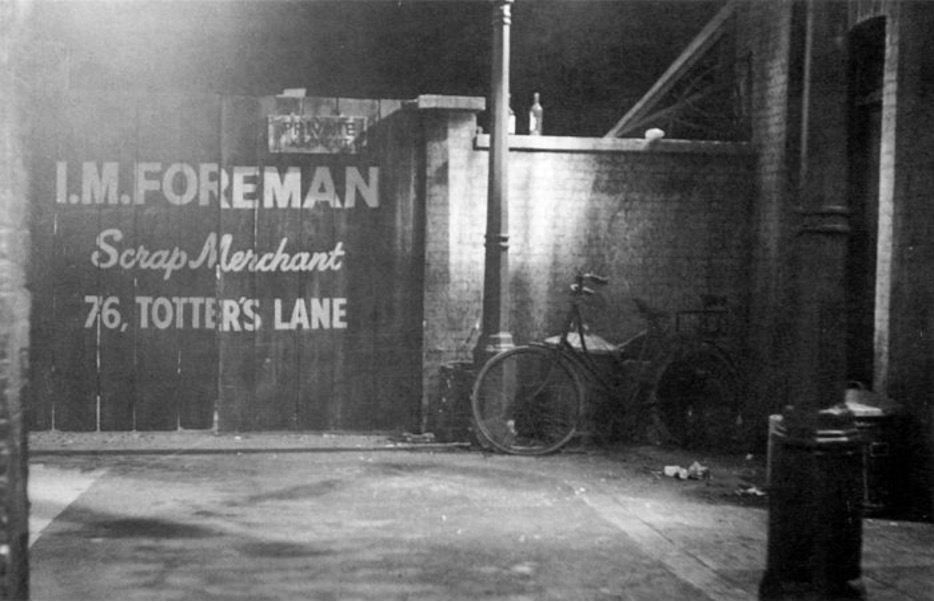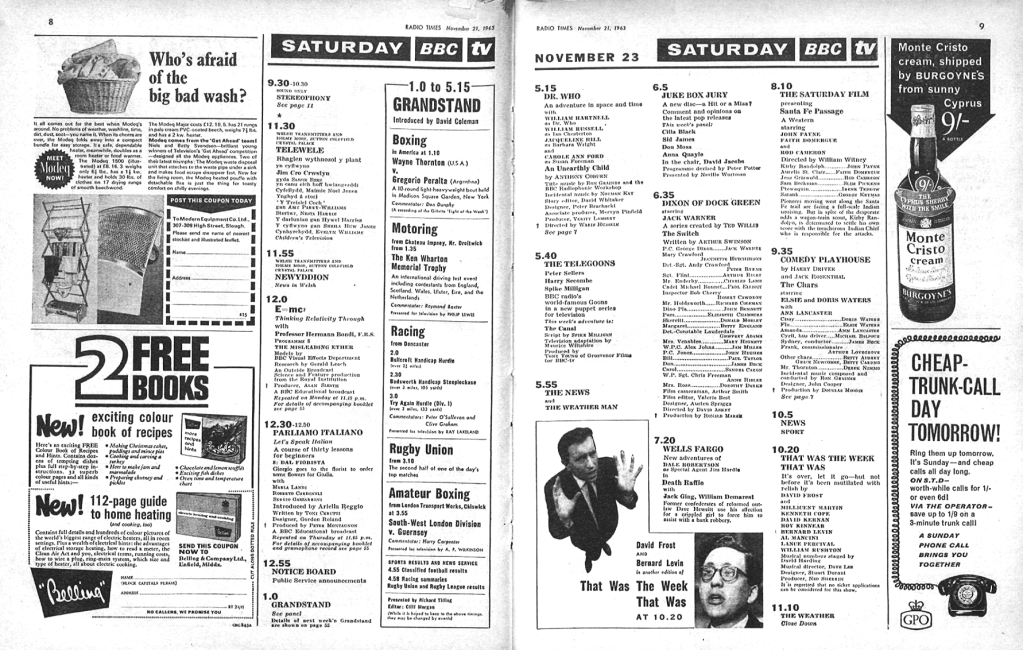
The story so far…
‘It all started out as a mild curiosity in the junkyard, and now it’s turned out to be quite a great spirit of adventure’
Let us take a trip back in time to 17:15 on Saturday 23rd November 1963. To a very different Britain, just 18 years after the end of the Second World War. It has already been an eventful year, coming after the Cuban Missile crisis and the narrow avoidance of a nuclear conflict the previous year, it was a cruel, cold winter (the Thames and parts of the sea had frozen), the resignation of John Profumo rocked the British political establishment and the popular young American president was assassinated the day before our first episode aired. The 60’s have yet to properly swing, the country is rebuilding after the war, rationing is in the (albeit recent) past now, the cities are still dark, coal-fired, smoggy places, but Britain is slowly shrugging off post-war austerity and is in the mood for change and for a party.
And change was in the air, the decade would soon switch from monochrome to technicolour – The Beatles had released ‘Please, Please me ‘ in the spring and the day before ‘An Unearthly Child’ aired, ‘With the Beatles’ was released, ‘The Freewheelin’ Bob Dylan’ also arrived in May. And yet the times weren’t quite ready to change just yet, we are still really in the tail end of the 1950’s. Across the decade the pace of change would be incredible – from culture, to science and technology, to social changes such as the comprehensive education system and the legalisation of homosexuality. But we are at the very start of all of that.
A gap in the Saturday Night Schedule

Over at television centre, Sydney Newman, the Head of Drama newly arrived from ABC, has identified a gap in the Saturday night BBC schedule. If you look at the schedules – on November 16th 1963, airing between Grandstand (an afternoon of sport running from 13:00 to 17:00 and a fixture of the BBC Saturday schedule) and the TeleGoons was Deputy Dawg. This featured the cartoon adventures of a talking dog, who was a Deputy Sherriff in the southern US and his battles with Muskie (the Muskrat) amongst other ‘varmints’. The rest of the evening line-up was ‘Juke Box Jury’ (a hugely popular music show where the great and good rated the releases this week), ‘Dixon of Dock Green’ (Jack Warner as an old school policeman). There was a gap that needed filling to tide the audience over from Grandstand and into the Saturday evening schedule and to avoid losing viewers to commercial TV and Sydney has an idea…
Newman and Donald Wilson (who he has just made Head of Serials after breaking up his script department) are working with writer C.E. Webber on the format of a new show to fill that gap. Newman is a fan of science fiction and Wilson had already commissioned a couple of reports on the genre from Alice Frick and John Braybon/Donald Bull – their recommendation that Time Travel, along with telepathy were areas worth looking at. It is a rather protracted gestation for show – ideas, concepts and personnel waxing and waning (Rex Tucker, Webber, Coburn) and opposition and politics from within the BBC – principally the design department, the Children’s department, but with scrutiny from Donald Baverstock (Controller of Programmes) and Joanna Spicer (Assistant Controller of Planning). Spicer is a legendary figure at the BBC, but was largely responsible for the show ending up at Lime Grove. Luckily for us, Sydney Newman isn’t the type to be dissuaded and neither is his new producer – Verity lambert. And she has support from an intelligent, erudite script editor – David Whittaker and a bright young director – Waris Hussein.
Everything is flux at this stage as the show heads towards production – from the number of episodes committed to by Baverstock, to the back story and relationship between the Doctor and Susan, the character names (Biddy, Lola, Suzan, Suzanne, Cliff…), the nature and name of the ship and the casting. Webber’s initial script (‘The Giants’) makes way for Coburn’s caveman story – although nobody is that keen on it. The format of the show though is now taking shape – a series of serials (each of 4-10 25-minute episodes). Historical, future and ‘sideways’ stories – with an educational element – science and history (represented by the schoolteachers) and strictly no Bug-Eyed Monsters. What could possibly go wrong?

Out of all of this flux, emerges ‘Doctor Who’. Shaped by Wilson, Lambert and Whittaker, built on a lot of the work of Webber and Coburn (although some of their odder ideas are excised) and with guiding input from Newman. Across this creative process, despite the surviving production and series guidance documentation, defining exactly who created what is rather difficult. As things begin to transition from page to screen, after an initial stutter of the rejected pilot episode, in the primitive, cramped, inappropriate confines of Studio D Lime Grove filming on the first episode begins. The initial transmission date slips from August to the more appropriate November. There is something about that opening episode that feels intrinsically wintry and dark. With the first episode now accepted by Newman, the show is ready to air.
We will possibly return to some of this and maybe some of the somewhat overlooked heroes of the creation of the show later. I will try to keep these digressions to a minimum – but these first couple of stories really deserve some context. Hopefully from then on it will mostly just be the story reviews.
But now, it is time to visit 76 Totters Lane and peak behind the gates of I.M Foreman’s Scrap Merchants on a dark, foggy London evening in the winter of nearly 60 years ago…